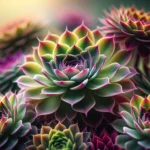Introduction to Etiolated Sempervivum
Have you ever noticed your chubby, rosette-shaped sempervivum, affectionately known as the ‘Hen and Chicks’, stretching towards the sky as if longing for the sun’s embrace? This phenomenon, known as etiolation, is a plant’s response to insufficient light. But why does this happen, and how does it affect these hardy succulents?
Etiolation is akin to a survival dance, where the plant elongates its stem in a desperate quest for sunlight, sacrificing its compact shape for a chance at life. It’s a stark reminder that, while sempervivums are tough plants originally hailing from the mountains of Europe, they too crave the sun’s kiss. In their natural habitat, they bask in bright, unfiltered light, and when deprived of such luxuries indoors, they reach out, strutting an elongated, paler version of themselves.
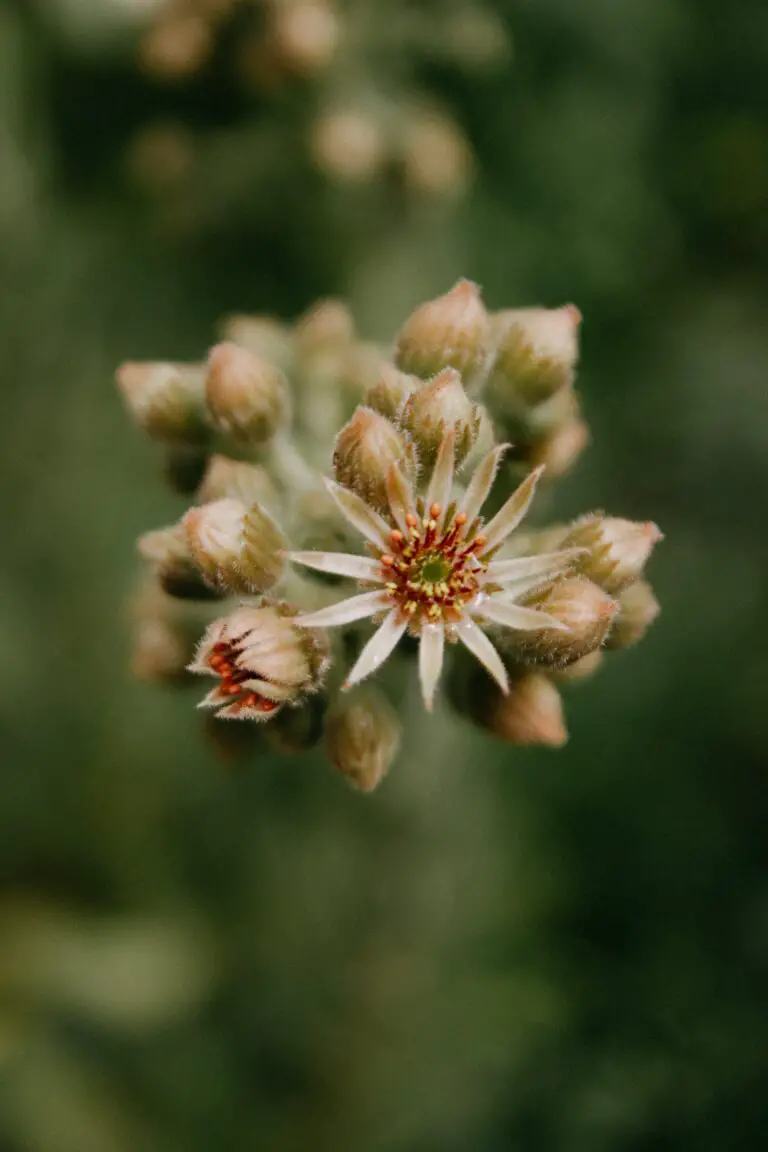
But don’t fret! This is not a death sentence for your green companions. Etiolation is a reversible condition with the right care and a bit of plant-parent attentiveness. For instance, by providing ample light or realigning your care routine, you can restore your sempervivum’s vigor and encourage it to flaunt its natural, compact beauty once more. It is a secret dance between caretaker and plant, one that, when mastered, results in a flourishing display of resilience and charm.
Understanding etiolation in sempervivums sets the stage for appreciating the importance of proper care. After all, these are not just plants; they are living sculptures, creating a tableau that whispers stories of survival and beauty in our homes. Let us delve deeper into their world, ensuring they thrive under our guardianship.
Identifying Etiolation in Your Succulents
Are your sempervivums reaching for the sky, all stretched out and leggy? It could be a classic case of etiolation, where our plump and compact friends are literally growing out of their comfort zone. Etiolation in sempervivums is like a plant’s silent cry for more sunlight, as they extend their stems in search of those golden rays they so desperately need.
Visual cues of etiolation in your succulents include elongated stems, leaves spaced farther apart, and a paler green color than usual. The leaves may also appear thinner, as the plant allocates its resources to growing taller rather than wider. Imagine a sempervivum that’s usually a compact rosette of vibrant green, now transformed into a lengthy, pale stretch of greenery—it’s the botanical equivalent of a teenager sprouting up without filling out.
If you’ve spotted what looks like a succulent high-rise in your plant collection, fear not. It’s an issue that can be managed with the right care and adjustments. Delving into the world of succulent plant care, you’ll discover tips on providing appropriate lighting conditions for your sempervivums to prevent etiolation.
To aid our stretched-out sempervivums, placing them in a brighter spot where they can soak up more sunlight is key. The goal is to emulate the natural, intense light they would enjoy in their native rocky habitats. Supplementing with grow lights during darker months can also be a game-changer. For more guidance and expert tips, have a look at our insightful article on cultivating your own thriving succulents. By mimicking a sempervivum’s ideal living conditions, we can help them regain their characteristic compact form and rich coloration.
Remember, the key to a happy sempervivum lies in understanding and acting upon the signs they show us. Once you’ve mastered the art of identifying and addressing etiolation, your succulent sanctuary will flourish with health and vibrancy.
The Science Behind Succulent Stretching
Picture a Sempervivum, commonly known as a Hen and Chicks plant, growing wild and free under the sun—its tightly-packed rosette lush and compact. But take that same plant and place it in the dim corner of a room, and you’ll witness a peculiar transformation: it starts stretching out as if reaching for something unseen. This odd behavior is known as etiolation, and it’s the plant’s Hail Mary to snag whatever light it can get.
What’s happening here? When a Sempervivum doesn’t get enough light, it triggers an evolutionary survival mechanism. In a bid to survive, the plant elongates its stem and grows its leaves farther apart in an attempt to maximize its exposure to light. This results in a leggy, weaker plant that’s a far cry from its robust natural state. It’s like a person leaning over a balcony as far as they can to grab a dropped penny—risky and somewhat desperate!
This stretching act isn’t just an aesthetic issue; it’s a sign of a plant in distress. Plants rely on light for photosynthesis, the process of converting light energy into chemical energy to fuel their growth. Without sufficient light, a plant can’t properly photosynthesize, which can lead to a host of problems, including a reduction in pigmentation, softening of the tissues, and an overall weakened state.
The etiolation isn’t irreversible, though. With the right light conditions and some TLC, an etiolated plant can bounce back. To see this process in action and get some hands-on tips, check out this informative video on why succulents become etiolated and how to fix them.
Preventing Stretch in Sempervivum
The key to preventing etiolation is simple—make sure your Sempervivum gets enough light! These plants are sun-worshippers and thrive with about six hours of direct sunlight each day. If they’re indoors, placing them by a south-facing window will usually give them the light they crave. However, when it’s not possible to provide natural sunlight, artificial grow lights are an excellent alternative. Remember, these plucky succulents want to stay compact and hardy, and they can, provided we mimic their native high-light conditions.
If you’re looking for more in-depth guidelines on how to prevent your Sempervivum from getting too leggy, there’s a wealth of information on the Succulent Eclectic site. Understanding the right conditions can make all the difference in keeping your succulents vibrant and healthy. Just like us, they need the right environment to really flourish.
So next time you see a Sempervivum stretching out, remember it’s not reaching for the stars—it’s reaching for the sun. And with the right light and care, you can help it thrive right where it is, grounded and full of life.
Preventing Etiolation: Optimal Conditions for Sempervivum
If you’ve set your sights on a succulent that’s superbly tough and tirelessly tantalizing, then bubble up with excitement, because sempervivums are the gladiators of the green world, my friends! This section is your treasure map to dodge the dreaded etiolation and groom these green gems into their fullest splendor. Buckle up as we unveil the secret light and temperature scrolls for sempervivum splendor!
Sempervivum, affectionately dubbed ‘hens and chicks,’ are sun worshippers. In their natural rocky terrain, they bask in full glory under the radiant beams. But when they begin stretching out like a kid reaching for the cookie jar – elongated stems and pallid leaves – that’s a cry for help! Etiolation, this stretchy phenomenon, is succulent speak for “more sunlight, please!”
To keep your sempervivums stout and spirited, position them in a spot where the sun isn’t just a fleeting guest. They crave at least six hours of direct sunshine to strut their vibrant hues and tight rosette form. Less light turns them into lanky, delicate shadows of their former selves. Think of it like sunbathing; without it, your succulents won’t get that enviable tan! Indoor growers, fear not; a sunny windowsill or a grow light can become your sempervivum’s sun-kissed sanctuary.
As for the thermostat settings, sempervivums are no divas. They thrive in a temperature range blissfully wide, from the frosty 40°F (4°C) up to a toasty 80°F (27°C). These tough cookies even flaunt their resilience through winter’s chills without batting a frosty eyelash. However, if it gets hotter than a summer fling, make sure they’re not baking; provide some afternoon shade to prevent sunscald, just like you’d seek a leafy retreat during a scorching beach day.
Let’s put the textbook to the side and peek into the diary of Daisy the sempervivum enthusiast. She’ll tell you her sempervivums used to stretch like lazy cats until she upgraded their pad with a full-spectrum LED. Since then, her chicks have been chubby and chuffed, clustering like a cozy succulent huddle. Daisy’s tip: mimic mother nature and your sempervivums will thank you with a boozy bouquet of colors!
Video Spotlight: Sempervivum Care Essentials
Now, if you’re a visual learner and you’re itching to see these succulent superheroes in action, check out this enlightening video on sempervivum care – it’s like having a personal succulent sensei!
And remember, great scapes start with great bases. So, why not dive deeper into the riveting realm of succulent care? For a more comprehensive view on how to make those green buddies blossom, check out our guide on thriving succulent care. After all, enlightened care for one can cascade onto all, cultivating a cornucopia of chirpy chicks!
Solutions for Etiolated Sempervivum: Rescue Techniques
Have you discovered your much-adored sempervivum stretching out toward the light, pale and lanky, a mere shadow of its former rosette glory? Fear not; your succulent doesn’t need to be consigned to the compost just yet! Etiolation – when plants grow thin and elongated due to insufficient light – can turn your plump, vibrant sempervivum into a ghostly figure. But with a few rescue techniques, you can rehabilitate your light-starved friend. Let’s roll up our sleeves and breathe new life into your etiolated sempervivum.
Pruning: Snip Your Way to Health
When etiolation has your sempervivum looking more like a beanstalk than a succulent, a generous trim can be the first step to redemption. Snip off the stretched portions of the plant to encourage a fresh start. Even if it feels like you’re giving your plant a drastic haircut, remember, this is tough love. After pruning, place your sempervivum in a spot where it can soak up plenty of indirect sunlight to prevent future etiolation.
Repotting: A Fresh Start
Your sempervivum’s roots could be wandering in search of nutrients, a sign that it’s time for a new home. Choose a well-draining potting mix and a snug pot to promote root health, which is essential in supporting a robust, compact growth pattern. As you repot, take the opportunity to inspect the roots for signs of rot or damage and trim away any unsavory bits, setting the stage for a stellar comeback.
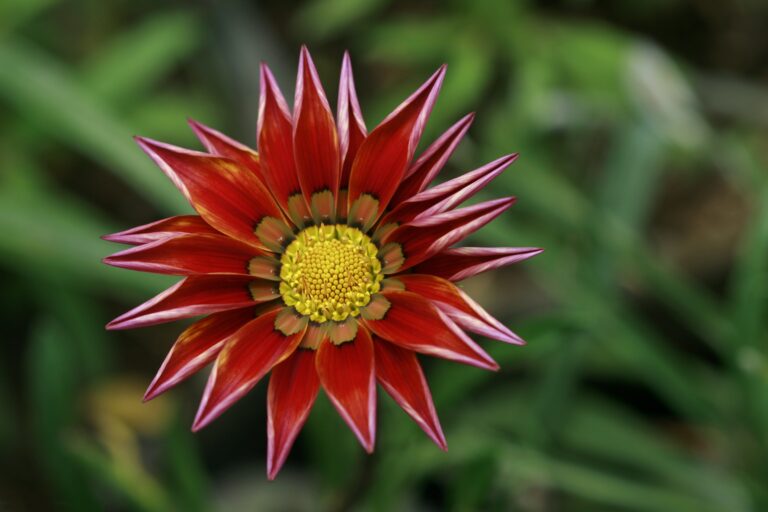
Adjusting Care Routines: Timing Is Everything
It’s not just where you place your sempervivum that counts, but also how you care for it. Overwatering is a common folly that leaves anyone’s thumb feeling far from green. Remember, sempervivums are drought-resistant troopers. Let the soil dry out between waterings to foster firm, healthy leaves, and only water deeply when required. Combine this with a nutrient-rich fertilizer during the growing season, and you’ll soon see your sempervivum return to its plump, happy self.
Imagine your etiolated sempervivum as the protagonist in its own comeback story. With these straightforward steps – a careful prune, a snug new pot, and a watering schedule that mimicks the dry climates it thrives in – you’ll turn the tide on etiolation. Your sempervivum will soon return as the centerpiece of your succulent collection, a testament to the resilience of these fascinating plants. It’s not just about saving a plant; it’s a tale of triumph, a glimpse at nature’s remarkable ability to revive and flourish with a bit of timely intervention.
Long-Term Wellness for your Hen and Chicks
Like nurturing a blossoming friendship, ensuring the long-term wellness of your Sempervivum, commonly known as Hen and Chicks, requires insight, attention, and the willingness to adapt. Let’s unravel the secrets to cultivating a relationship with these resilient succulents that transcends the seasons, making them thrive in your care.
First things first, watering your Sempervivum — it’s all about balance. Picture this: a sun-kissed Mediterranean cliffside where these succulents would naturally call home. Sparse rainfall yet ample drainage — that’s your cue for watering techniques. Mimic nature by allowing the soil to dry between waterings, ensuring each sip is deep enough to quench the roots but never so abundant that it causes soggy feet. After all, overindulgence is as much a faux pas in plant care as it is at a dinner party.
Now, soil selection is your stage for showcasing these radiant rosettes. Opt for a well-drained mix, akin to their rocky native habitats. A blend of potting soil, coarse sand, and fine pumice or perlite invites the perfect balance of aeration and nutrients. Envisage your plant in a cozy, breathable abode, free from the clutches of compaction.
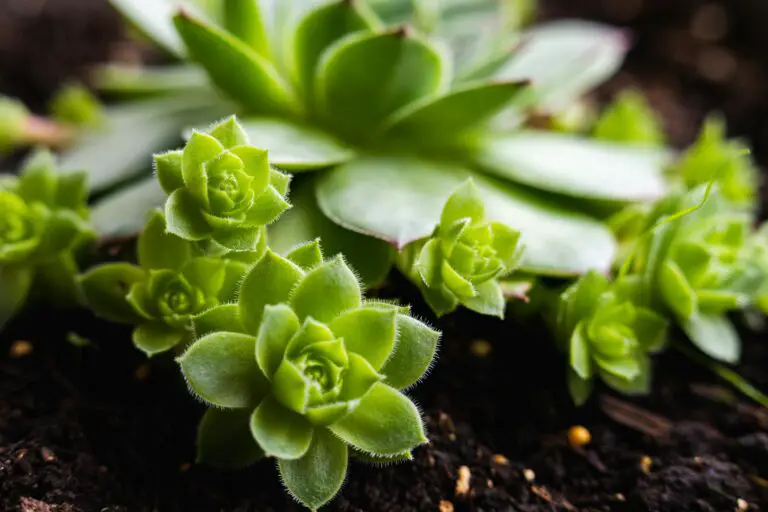
Embracing seasonal care variations is like dancing to the tune of nature’s rhythms. In the exuberance of summer, your Hen and Chicks may revel in the outdoor sun, though caution against a midday scorch is wise. Conversely, winter’s chill calls for a strategic retreat indoors or under the protective awning of a cold frame. It’s a delicate waltz between the sun’s embrace and shadow’s shelter, ensuring your Sempervivums stay evergreen, rather than succumbing to the etiolated pallor of neglect.
Mastering these essentials — watering with purpose, soil savvy, and seasonal subtleties — will crown you the guardian of eternally spirited Sempervivums. They’ll repay your guardianship with a tapestry of textured, vivid beauty that defies the ebb and flow of time. Remember, it’s not just about survival; your Hen and Chicks held in the palm of informed care are destined for a display that’s nothing short of spectacular.
Understanding the Lifecycle of Sempervivum
Welcome to the world of sempervivums, where resilience meets beauty! These plucky plants, often favored for their low maintenance and robust nature, have a fascinating lifecycle that, once understood, can greatly enhance your ability to care for them, especially when it comes to preventing etiolation, a condition that can leave them stretched and pale.
The Start of the Journey: Seeds to Rosettes
Sempervivum’s life begins as a tiny seed and, with the right touch of warmth and moisture, it embarks on its miraculous journey. Fast forward a few weeks, and you’ll witness the emergence of a symmetrical rosette, an iconic shape that defines these succulents. These young rosettes are the epitome of energy and potential, packing a voracious growth spell, especially in their early stages. It’s here that the right balance of light and space is crucial to preventing the dreaded etiolated sempervivum—a stretched-out plant striving for light.
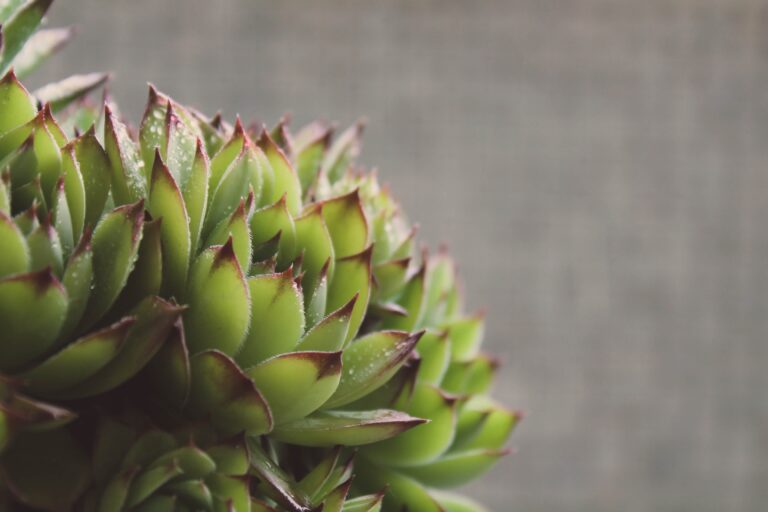
The Yearly Cycle: Growth Spurts and Dormancy
With the wax and wane of seasons, your sempervivums will go through periods of vigorous growth, followed by rest. Picture them in spring and summer with their spirited growth spurts, unfolding leaves like nature’s origami. Then comes fall, a prelude to dormancy, with winter’s chill urging them into a restful hibernation. These cyclic patterns mirror nature’s pulse and your sempervivum’s needs change accordingly. Too much warmth and not enough light during winter can stimulate etiolation, leading to elongated and weak plants. It’s a dance with nature that requires a watchful eye.
Blooming and Propagation: The Circle of Life
As your sempervivum matures, it prepares for a one-time spectacular event: blooming. This celebration of life is bittersweet, as it signals the end for the flowering rosette. However, don’t despair! Before its grand exit, it offers a parting gift by producing offsets—miniature versions of itself—that surround the mother plant. These offsets are your opportunity to propagate, continuing the sempervivum legacy. Careful nurturing during this phase ensures a robust new generation, far from the weak, pallid grasp of etiolation.
Embracing the lifecycle of sempervivum means building a bond with living sculptures that change with the seasons. By offering an understanding hand, adjusting care, and recognizing each phase’s unique needs, you’ll be rewarded with a sempervivum that stands strong and vibrant, a true testament to the resilence of nature.
Case Studies: Before and After Etiolation Treatment
Stepping into the world of sempervivums is like discovering a hidden gem of resilient beauty. But what happens when these hardy succulents face a little too much shadow and not enough sun? Etiolation—a word that might sound like a complex dance step—is actually a hurdle some plant enthusiasts encounter. It’s when our beloved sempervivums stretch out, reaching for light, and in the process, lose their compact rosette allure.
We’ve gathered heartwarming testimonials from succulent savants who have danced the etiolation tango and emerged victorious. These are real-life stories that not only inspire but provide a blueprint for success that you can replicate with your own leafy friends.
From Gloom to Bloom: Sarah’s Sempervivum Story
Sarah, a long-time member of the urban garden community, watched her favorite sempervivum, ‘Hector’, elongate hopelessly on her shaded balcony. Desperate for a solution, she adopted a regimen of gradual light exposure. Like guiding a sleepy child out of bed, she slowly reintroduced ‘Hector’ to the sun’s embrace. Within weeks, the stretched stalks began reverting to their original stout elegance—a true testament to the sempervivum’s resilience.
The Balcony Oasis: Jason’s Drastic Turnaround
Jason faced a similar plight. His green retreat, a lineup of potted sempervivums, began to reach for the sky in a leggy plea for sunshine. By rearranging his plant buddies to a sunnier locale and enforcing stricter watering routines, Jason turned his balcony into an oasis, and his sempervivums back to their former chubby-cheeked selves.
The joy in these shared experiences is palpable, showcasing the unwavering spirit of sempervivums when given a nudge in the right direction. It’s your turn to witness these transformations and soak up the wisdom from success stories that affectionately showcase the resilience of the etiolated sempervivum bouncing back to vibrant health.
Draw inspiration from these visual before and after sagas, and remember, an etiolated sempervivum isn’t a lost cause—it’s a pivot point for an exciting comeback story. Embrace the journey, encourage the best practices, and watch as your succulents thrive under your newfound expertise.
Frequently Asked Questions
Are you puzzling over your pale, stretched-out sempervivum and wondering why it looks more like a lanky sea creature than a compact, vibrant succulent? Fear not! You’re not alone in your quest for the secrets to a thriving etiolated sempervivum. Let’s dive into the most pressing questions gardeners face with these intriguing plants.
What Causes Etiolation in Sempervivum?
First things first: etiolation is like a plant’s plea for more sunlight. Imagine a sunbather reaching for the last rays at sunset—that’s your sempervivum stretching in search for light. This survival strategy can happen indoors or in shady spots where the sun is more of a myth than a daily reality.
Can Etiolation Be Reversed?
The short and sweet answer is: not exactly. Once the sempervivum has stretched, it’s a bit like a stretched-out sweater—there’s no going back to the original form. However, with better lighting and care, you can certainly encourage a dense, healthy new growth at the center of the plant. Just think of it as guiding your sempervivum back to its best self.
How Do I Prevent My Sempervivum from Becoming Etiolated?
Prevention is the name of the game here. Sempervivum thrives with ample sunlight, so place it where the sun can lavish it with attention—like a southern window or, weather permitting, outside. Get to know your plant’s preferences and watch it flourish under the right conditions. It’s like finding the perfect spot for your beach umbrella. Once you nail it, you’re in for a good time.
For a visual guide on nurturing your leggy sempervivum back to health, check out this insightful video:
My Sempervivum Is Etiolated, What Should I Do Now?
Don’t panic. Give your sempervivum a sunny makeover by gradually increasing its exposure to light. Avoid direct afternoon sunlight right away, as that could shock your little guy. It’s like easing into a hot bath—start slow, or you’ll get burned. After some time, new rosettes will form, and your sempervivum will be on its way to a full recovery.
Are There Varieties of Sempervivum That Are Less Prone to Etiolation?
All sempervivum varieties love the limelight of the sun, but some do have a higher tolerance for low light conditions. When picking your plant, think of it as choosing a friend. Some are happy to lounge in a dim café all day, while others crave the bustle of a sunny park. Choose a variety that fits your environment to set you both up for success.
Remember, having an etiolated sempervivum isn’t the end of the world. It’s an opportunity to learn more about your green companion and to grow together—quite literally! Keep these tips in mind, and your sempervivum will soon be the talk of the town (or at least your windowsill).

